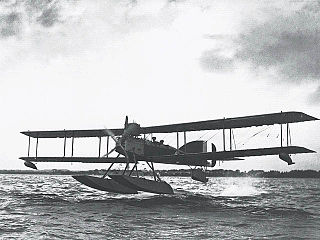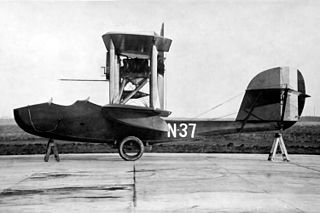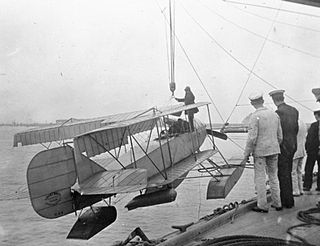Operators
 United Kingdom
United Kingdom
 Greece
Greece
| Gunbus | |
|---|---|
| Role | Fighter aircraft |
| National origin | United Kingdom |
| Manufacturer | Sopwith Aviation Company |
| First flight | 1914 |
| Primary users | Royal Naval Air Service Royal Hellenic Navy |
| Number built | 12 (Seaplanes) 23 (Gunbuses) |
The Sopwith Gunbus was a British fighter aircraft of the First World War. It was a single-engined pusher biplane based on a floatplane built by Sopwith before the war for Greece. Small numbers were built and used by the British Royal Naval Air Service, mainly as a trainer.
In 1913 the Sopwith Aviation Company received an order for six two-seat floatplane from the Greek Government for the Greek Naval Air Service, which was in the process of being set up on the basis of advice from Rear Admiral Mark Kerr, the head of the British Naval Mission to Greece. [1] [2] Sopwith's design, known as the "Pusher Seaplane" or "Greek Seaplane" was a single-engined pusher biplane powered by a single 100 hp (75 kW) Anzani radial engine, with four-bay wings. It was fitted with dual controls for use as a trainer. [3]
The first of the Greek Pusher Seaplanes flew in February 1914, successfully passing trials in March, with first deliveries in May and all six delivered by the outbreak of the First World War. Two more identical trainers were purchased by the Royal Naval Air Service, again for use as trainers, these being delivered in May. [2] While the Greek machines performed well, despite the limited facilities available at their base at Eleusina, with at first no workshops or hangars available, [3] the two British aircraft were less successful, with their engines proving unreliable, and were withdrawn by February 1915. [2]
In March 1914, the Greeks placed an order for six more pusher seaplanes, the Sopwith S PG N, which were similar to their previous aircraft, but rather than being dual control trainers, were to be armed with a machine gun in the nose, and powered by a Gnome Monosoupape rotary engine. [3] At least five of these aircraft were taken over by the Royal Navy at the outbreak of war, but again proved unsuccessful in British Service, with at least two being modified as landplanes. They remained in service until July 1915. [2]
The Royal Navy ordered six modified landplane based on the S PG N in July 1914, the Sopwith Gunbus or Admiralty Type 806, to be powered by 110 hp (82 kW) Sunbeam water-cooled V8 engines and armed with a machine gun. The first one flew on 6 October 1914, and was found to be underpowered, so was fitted with a 150 hp (112 kW) Sunbeam. [2] A further 30 aircraft were ordered from Robey & Co. Ltd. of Lincoln in early 1915, these being fitted with a modified nacelle, with the pilot sitting in the forward cockpit rather than the gunner, and fitted for bombing. Only 17 of these aircraft were completed, with the remaining 13 delivered as spare parts. [4]
The Sunbeam-powered Gunbuses saw limited operational use, with one aircraft being on the strength of the RNAS squadron at Dunkirk led by Commander Charles Samson in February 1915, with Samson commenting that the Sopwith required "a lot of work on it to make it safe to fly". [5] The Gunbuses were used mainly as trainers, being used by the RNAS at Hendon, [6] and remaining in service until the winter of 1915–16. [7]
The name Gunbus came from the Royal Flying Corps (RFC) pilot's slang term for an aeroplane, a bus , and was also used in the name of the Vickers Gunbus.
Data from War Planes of the First World War:Fighters Volume Two [7]
General characteristics
Performance
Armament
Aircraft of comparable role, configuration, and era
Related lists

The Sopwith T.1 Cuckoo was a British biplane torpedo bomber used by the Royal Naval Air Service (RNAS), and its successor organization, the Royal Air Force (RAF). The T.1 was the first landplane specifically designed for carrier operations, but it was completed too late for service in the First World War. After the Armistice, the T.1 was named the Cuckoo.

The Fairey Aviation Company Fairey III was a family of British reconnaissance biplanes that enjoyed a very long production and service history in both landplane and seaplane variants. First flying on 14 September 1917, examples were still in use during the Second World War.

The Sopwith Tabloid and Sopwith Schneider (floatplane) were British biplanes, originally designed as sports aircraft and later adapted for military use. They were among the first successful types to be built by the Sopwith Aviation Company. The "Tabloid", so named because of its small size, caused a sensation when it made its first public appearance.

The Vickers F.B.5 was a British two-seat pusher military biplane of the First World War. Armed with a single .303 in (7.7 mm) Lewis gun operated by the observer in the front of the nacelle, it was the first aircraft purpose-built for air-to-air combat to see service, making it the world's first operational fighter aircraft.

The Sopwith Baby was a British single-seat floatplane used by the Royal Naval Air Service (RNAS) from 1915.
The Fairey Hamble Baby was a British single-seat naval patrol floatplane designed and built by Fairey Aviation for the Royal Naval Air Service

The Short Admiralty Type 184, often called the Short 225 after the power rating of the engine first fitted, was a British two-seat reconnaissance, bombing and torpedo carrying folding-wing seaplane designed by Horace Short of Short Brothers. It was first flown in 1915 and remained in service until after the armistice in 1918. A Short 184 was the first aircraft to sink a ship using a torpedo, and another was the only British aircraft to take part in the Battle of Jutland.
The Sopwith Admiralty Type 807 was a 1910s British biplane seaplane designed and built for the Admiralty by the Sopwith Aviation Company.

The Sopwith Admiralty Type 860 was a 1910s British biplane seaplane torpedo bomber designed and built for the Admiralty by the Sopwith Aviation Company.
The Grain Griffin was a British carrier-based reconnaissance aircraft developed and built by the RNAS Marine Experimental Depot, Port Victoria, during the First World War. A development of the unsuccessful Sopwith B.1 bomber, the Grain Griffin was a two-seat single-engined biplane that was built in small numbers for Britain's Royal Naval Air Service, being used operationally during the British intervention in the Russian Civil War.

The Norman Thompson N.T.2B was a British single-engined flying boat trainer of the First World War. A single-engined biplane, the N.T.2B was adopted as a standard flying boat trainer by the Royal Naval Air Service, training pilots for larger patrol flying boats such as the Felixstowe F.2.

The White and Thompson No. 3 was a British flying boat of the First World War. While the prototype was originally designed to compete in an air-race around the UK, eight more similar aircraft were built for the Royal Naval Air Service.
The Westland N.1B was a prototype British single-engined floatplane fighter aircraft of the First World War. The first aircraft to be designed by Westland Aircraft, it was a single-engined tractor biplane. Despite good performance, only two aircraft were built, the Royal Naval Air Service operating landplane fighters from ships instead.

The Norman Thompson N.1B was a prototype British flying boat fighter aircraft of the First World War. A two-seat single-engined pusher biplane, a single example was built in 1917, but no production followed.
The Sopwith Three-seater was a British aircraft designed and built prior to the start of the First World War. One of the first aircraft built by the Sopwith Aviation Company, it was operated by both the Royal Naval Air Service (RNAS) and the Royal Flying Corps (RFC), being used briefly over Belgium by the RNAS following the start of the War.

The Sopwith Bat Boats were British flying boats designed and built from 1912 to 1914. A single-engined pusher biplane, the Bat Boat was the first successful flying boat and amphibious aircraft built in the United Kingdom, with examples used by the Royal Navy and by Greece and Germany.

The Short S.41 was a British single-engined biplane built for the Royal Navy in 1912. Capable of being operated either on wheels or floats, it was successful enough for a further two similar aircraft to be built, with the type remaining in use until the early years of the First World War.
The Port Victoria P.V.9 was a British single-seat biplane floatplane fighter of the First World War. Although claimed to be the best aircraft of its type yet to be tested, only a single prototype was built.

The Short Admiralty Type 81 was a series of British two-seat floatplanes built prior to the First World War, and used by the Royal Naval Air Service in the early years of the war. They were powered by 160 hp (120 kW) Gnome Lambda-Lambda 14 cylinder two-row rotary engines and had folding wings to aid storage on ship, hence the popular name Short Folder, shared with a number of other seaplanes made by Short Brothers.
The Sage Type 4 was a prototype British floatplane of the First World War. It was a designed as a two-seat reconnaissance aircraft for the Royal Naval Air Service, but was chosen for service as a floatplane trainer, although the end of the war resulted in production being cancelled.